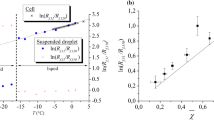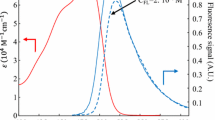Abstract
When droplets of purified water (1–5 μl) were cooled from the bottom, they slowly and continuously supercooled before releasing latent heat as a transient burst of infra-red (IR) radiation. In order to determine the role of this IR emission, a thin rectangular water layer was cooled unilaterally while imaged from above by an infrared (FLIR) camera. The first noticeable event was an IR burst that rapidly (< 0.1 s) moved through a 5-mm-long path of water. Final solidification of the water layer was recognized by an increase in volume, as the meniscus at the air interface changed from concave to convex. The propagation of the IR burst through the water layer preceded the first visible onset of volume increase and solidification by more than one second. The transient and early appearance of the IR burst belongs to what is called the first stage of freezing. This stage has been linked to the formation of so-called spongy ice. Both IR burst and pinnately shaped spongy ice appear at the same time and share a short transient existence. It is only this early type of ice that is associated with the IR burst. By contrast, the later-occurring solid ice formation parallels a diminishing IR emission.







Similar content being viewed by others
References
T Takahashi J. Atmos. Sci. 35 1536 (1978).
P Mazur Science 168 939 (1970)
M S Brown, E S B Pereira, B J Finkle Plant Physiol. 53 709 (1974)
Bauerecker, P Ulbig, V Buch, L Vrbka, P Jungwirth J. Phys. Chem. C 112 7631 (2008)
D B Idle Ann. Bot. 30 199 (1966).
V F Petrenko, R W Whitworth Physics of ice (London: Oxford University Press) (1999).
B M Weckhuysen Chem. Soc. Rev. 39 4802 (2010).
W C Macklin, B F Ryan J. Atmos. Sci. 22 452 (1965) https://journals.ametsoc.org/doi/pdf/ https://doi.org/10.1175/1520-0469(1965)022%3c0452:tsoigi%e2.0.co%382
Y Furukawa, W Shimada J. Cryst. Growth 1128 234 (1993)
W C Macklin, B F Ryan (1962) Q. J. R. Meteorol. Soc. 88(378) 548 (1962)
J Palca J Scientists keep water below zero liquid far below zero degree. NPR, Science, Morning Edition, Article #1233376191(2010)
Fuller, M P, Wisniewski, M (1998) J. Therm. Biol. 23: 81 (1998)
S Shimokawa, T Yokono, T Mizuno, H Tamura, T Erata, T Araiso (2004) Jpn. J. Appl. Phys. 43 L545 (2004).
J D Brownridge (2011) Am. J. Phys. 79 78 (2011)
Y Tao, W Zou, J Jia, W Li, D Cremer J. Chem. Theory Comput. 13 55 (2017)
M Kowacs, M Marchel, L Juknaite, J M S Esperanca, M R Romao, A L Carvalho, L P Rebelo (2017) J. Cryst. Growth 457 362 (2017)
R R Gilpin Int. J. Heat Mass Transf. 20(6) 693 (1977) https://doi.org/10.1016/0017-9310(77)90057-6.
J J M Guzman, S L Braga Int. J. Thermophys. (2005) 26 1781.(2005). https://doi.org/10.1007/s10765-005-8596-1.
D E Pegg Methods Mol. Biol. 368 39 (2007)
T G Nunes, E W Randall, G Guillot Solid State Nuclear Magn. Reson. 32 59 (2007)
A A Shibkov, Y I Golovin, M A Zheltov, A A Korolev, AA Leonov J. Cryst. Growth 236 434 (2002)
E So, R Stahlberg, G H Pollack (eds.) D W Pepper and C A Brebbia Water Soc., p 3 (2012)
G H Pollack The Fourth Phase of Water: Beyond Solid, Liquid and Vapor (USA, Seattle: Ebner & Sons) p 135 (2013) www.ebnerandsons.com.
Author information
Authors and Affiliations
Corresponding author
Rights and permissions
About this article
Cite this article
Stahlberg, R., Yoo, H. & Pollack, G.H. Origin of the infra-red emission peak in freezing water. Indian J Phys 93, 221–227 (2019). https://doi.org/10.1007/s12648-018-1265-6
Received:
Accepted:
Published:
Issue Date:
DOI: https://doi.org/10.1007/s12648-018-1265-6
Keywords
- Ice formation
- Phase transition
- Spongy ice formation
- Dendritic ice
- Peak in infra-red emission
- IR heat dissipation




